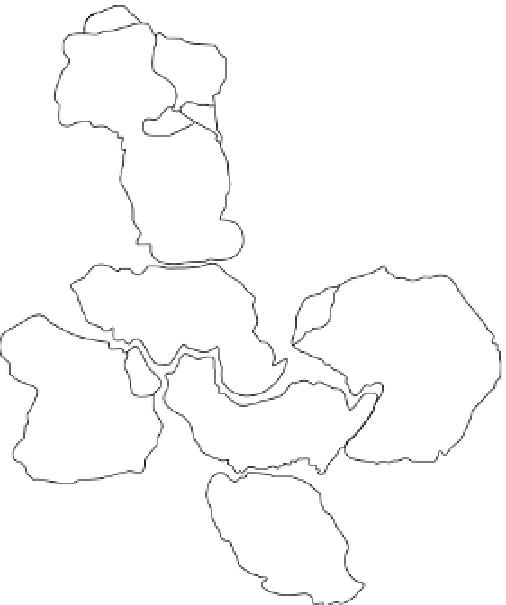Geoscience Reference
In-Depth Information
0 km
Chile
Kurile
Hellenides
S. Sandwich
Warm Slabs
To n g a
Appennines
TZ
Main slab filter
Mariannas
N. Chile
1000
km
Sumatra
D
MESOSPHERE
ε
c
LOWER MANTLE
(isolated
ε
c
stagnant)
D
′′
Fig. 4.3
Slabs have a variety of fates in the mantle. They
sink to various depths and warm up at different rates. Some
underplate continents, some have shallow dips, some are
nearly vertical. A very few sink into the transition region
(400--1000 km depth).
NAZ
SAM
6
UNSTABLE
NAM
4
2
EUR
PHI
0
PAC
?
?
?
?
AFR
−
2
?
?
?
?
?
?
??
INA
−
4
?
?
?
−
6
ANT
?
?
?
?
STABLE
−
8
0
20
40
60
80
100
Fig. 4.5
A disjointed Lambert equal-area projection
centered on each plate. Note the band of medium-sized
plates encircling the large African and Pacific plates. Note the
similarity in shape of AFR and PAC, and of EUR and INA.
Oceanic Plate Age (Myr)
Fig. 4.4
Buoyancy of plates as a function of age and crustal
thickness. Young plates and plates with thick crust (seamount
chains, plateaus) may stay in the shallow mantle and be
responsible for melting, or fertility, anomalies (after Van
Hunen
et al
., 2002).
and sizes that move over the surface. They
are separated by boundaries that meet at triple
junctions. There are also many broad zones of
deformation (see Figure 4.5). The seven major
plates account for 94% of the surface area of
the Earth (Table 4.1). Some authors recognize
20 plates and an equal number of broad zones of
The topology of plates
Plate tectonics on Earth, at present, consists of
about a dozen large plates, of irregular shapes














































